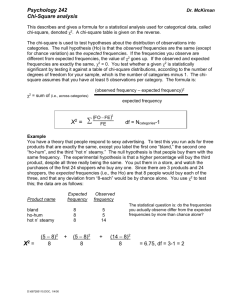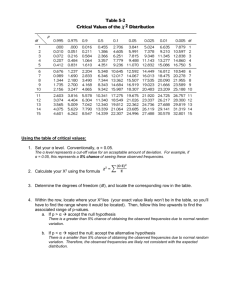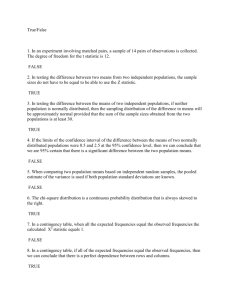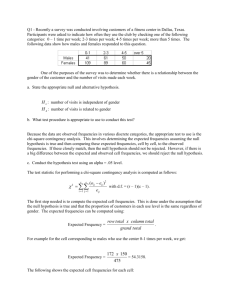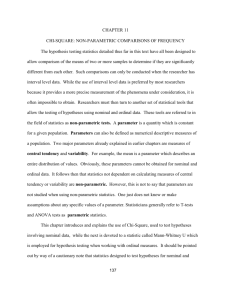answer - Hatem Masri
advertisement
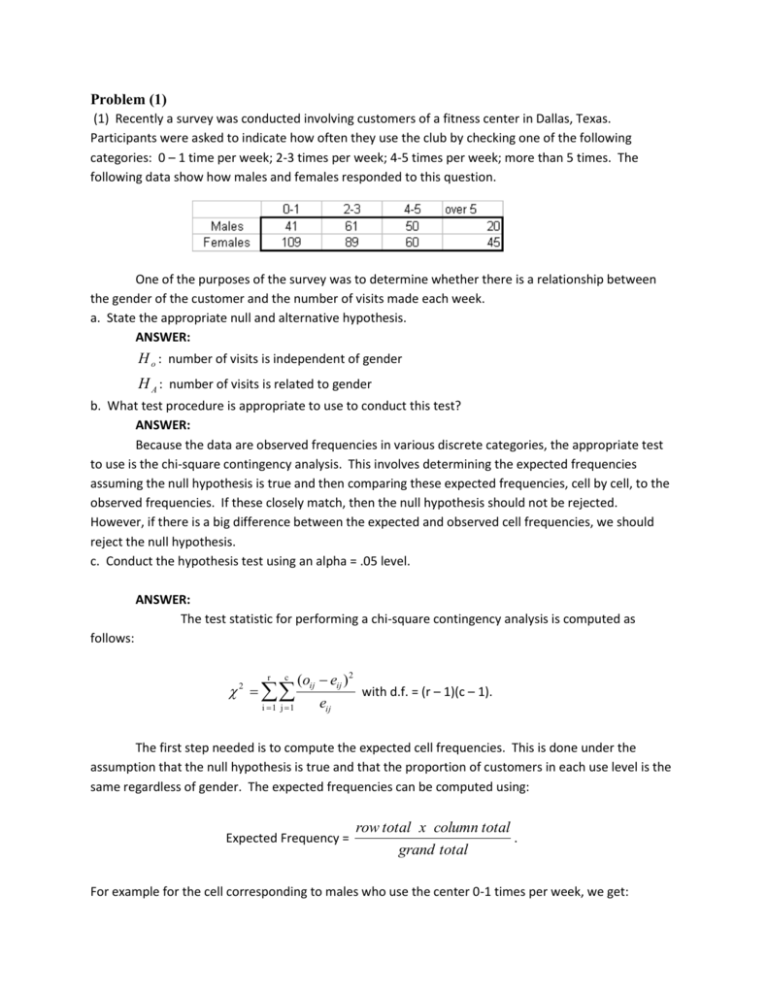
Problem (1) (1) Recently a survey was conducted involving customers of a fitness center in Dallas, Texas. Participants were asked to indicate how often they use the club by checking one of the following categories: 0 – 1 time per week; 2-3 times per week; 4-5 times per week; more than 5 times. The following data show how males and females responded to this question. One of the purposes of the survey was to determine whether there is a relationship between the gender of the customer and the number of visits made each week. a. State the appropriate null and alternative hypothesis. ANSWER: H o : number of visits is independent of gender H A : number of visits is related to gender b. What test procedure is appropriate to use to conduct this test? ANSWER: Because the data are observed frequencies in various discrete categories, the appropriate test to use is the chi-square contingency analysis. This involves determining the expected frequencies assuming the null hypothesis is true and then comparing these expected frequencies, cell by cell, to the observed frequencies. If these closely match, then the null hypothesis should not be rejected. However, if there is a big difference between the expected and observed cell frequencies, we should reject the null hypothesis. c. Conduct the hypothesis test using an alpha = .05 level. ANSWER: The test statistic for performing a chi-square contingency analysis is computed as follows: r c 2 i 1 j 1 (oij eij ) 2 eij with d.f. = (r – 1)(c – 1). The first step needed is to compute the expected cell frequencies. This is done under the assumption that the null hypothesis is true and that the proportion of customers in each use level is the same regardless of gender. The expected frequencies can be computed using: Expected Frequency = row total x column total . grand total For example for the cell corresponding to males who use the center 0-1 times per week, we get: Expected Frequency = 172 x 150 = 54.3158. 475 The following shows the expected cell frequencies for each cell: ( o e) 2 . For example in the cell for males and use between 0 and 1, e Next for each cell we compute: we get: (41 54.3158) 2 3.26 . 54.3158 Below we show the computation for each cell: 0-1 2-3 4-5 over 5 Males 3.264433 0.822572 2.59585 0.531475 Females 1.853077 0.466939 1.473552 0.301696 The chi-square test statistic is computed by summing these values giving r c 2 i 1 j 1 (oij eij ) 2 eij =11.309. The critical value for the contingency analysis test with (2-1) x (4-1) = 3 degrees of freedom and alpha equal .05 is found in the chi-square table to be 7.8147. The decision rule is: If 2 > 7.8147, reject the null hypothesis Otherwise, do not reject. Since 2 =11.309 > 7.8147, reject the null hypothesis and conclude that use rate is related to gender of the customer. Problem (2) The following regression output is the result of a multiple regression application in which we are interested in explaining the variation in retail price of personal computers based on three independent variables, CPU speed, RAM, and hard drive capacity. However, some of the regression output has been omitted. Given this information and your knowledge of multiple regression, what is the value for the standard error of the estimate? ANSWER: The standard error of the estimate is a measure of the deviation of the fitted y values around the actual y values. The formula for the standard error is: SEE MSE However, the MSE is not given directly in the above output. We can compute it using the following formula: MSE SSE n k 1 where SSE = Sum of Squares Error or Sum of Squares Residual and n = 36 and k = 3. The Sum of Squares Residual is not given either, but can be computed as: SSE TSS SSR and TSS and SSR are given in the ANOVA section of the regression output. Thus, we get: SSE = 49,327,250 - 34,335,283 = 14,991,967 Therefore, we get: MSE 14,991,967 36 3 1 = 468,499 Then, the standard error of the estimate is: SEE MSE 468,499 684.47
